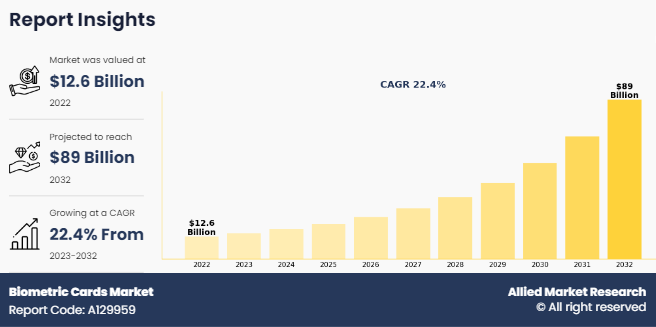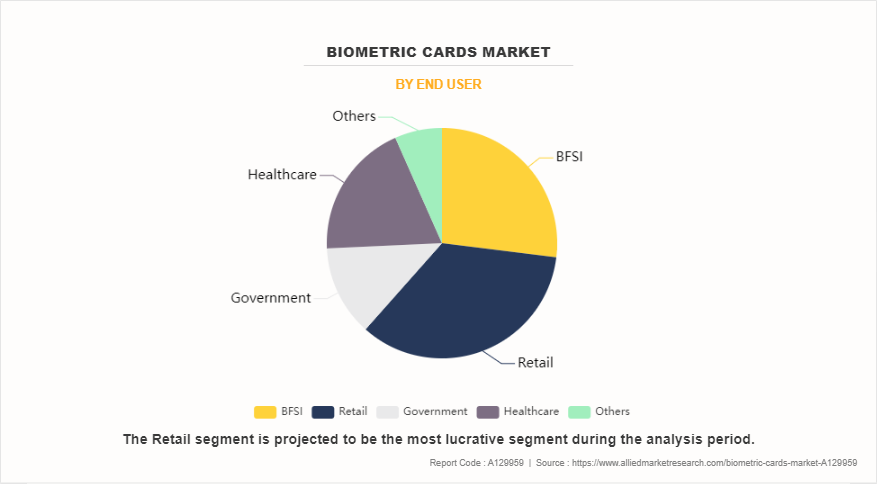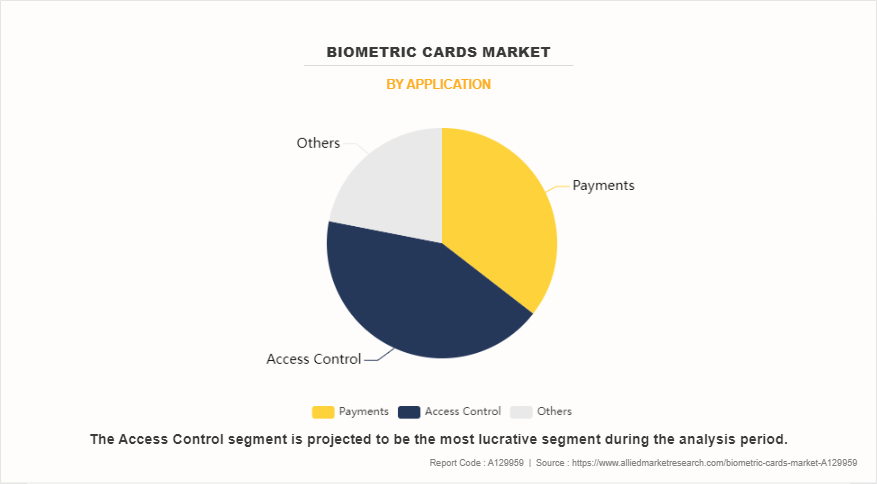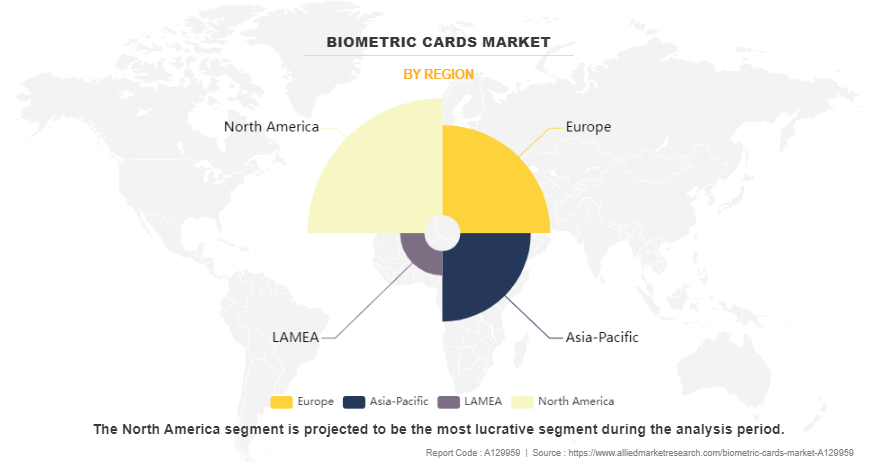Biometric Cards Market Research, 2032
The Global Biometric Cards Market size was valued at $12.6 billion in 2022 and is projected to reach $89 billion by 2032, growing at a CAGR of 22.4% from 2023 to 2032.
Biometric cards are identification cards that incorporate biometric technology, typically fingerprint reader, iris, facial recognition, and thumbprint device, to verify the identity of the cardholder. These cards store biometric data securely within a microprocessor chip embedded in the card. When used for authentication or access control, the cardholder's biometric information is compared with the stored data to confirm identity. Biometric card manufacturers offer enhanced security and reliability compared to traditional identification methods like passwords or PINs, as biometric traits are unique to individuals and difficult to replicate. They find applications in various sectors such as banking, government services, healthcare, and access control systems.
Key Takeaways
- Based on application, the access control sub-segment emerged as the global leader in 2022 and the payments sub-segment is anticipated to be the fastest growing during the forecast period.
- Based on end users, the retail sub-segment emerged as the global leader in 2022 and is predicted to show the fastest growth in the upcoming years.
- Based on region, North America registered the highest market share in 2022 and Asia-Pacific is predicted to show the fastest growth in the upcoming years.

Market Dynamics
There is a rising demand for secure authentication methods due to the increasing concerns about identity theft, fraud, and unauthorized access. Biometric card manufacturers offer a higher level of security compared to traditional authentication methods like passwords or PINs. Biometric cards market insights into biometric data, such as fingerprint readers, iris patterns, or palm veins, and thumbprint devices are unique to each individual, making it extremely difficult for unauthorized users to gain access. Traditional methods of authentication, such as passwords or PINs, are susceptible to fraud through techniques like phishing or shoulder surfing. Biometric cards mitigate these risks by directly linking the user's identity to their biological characteristics, making it much harder for fraudsters to impersonate someone else.
With the increasing regulations around data security and privacy (such as GDPR in Europe), organizations are under pressure to implement more secure authentication methods. Biometric card companies offer a solution that aligns with these compliance requirements by providing strong, multifactor authentication. Moreover, the combination of increased security needs, regulatory pressures, and improved user experience is driving the growth of biometric cards growth drivers as organizations seek robust solutions to protect against identity theft and fraud.
Biometric cards typically involve more sophisticated technology compared to traditional cards, making them more expensive to produce. This cost can be a significant barrier, especially for widespread adoption in sectors where budgets are constrained. Biometric cards involve more complex manufacturing processes compared to traditional cards, which typically include embedding biometric sensors and integrating sophisticated algorithms for authentication. These additional components and processes contribute to higher production costs for biometric card companies. Mass production can help reduce the unit cost of biometric ID cards.
However, achieving economies of scale may be challenging, especially during the initial stages of adoption when demand may be relatively low. This can further inflate the per-unit cost of biometric cards. Moreover, while biometric ID cards offer enhanced security features compared to traditional cards, ensuring the integrity of biometric data requires robust security measures. Investments in encryption, authentication protocols, and data protection mechanisms add to the overall cost of implementing biometric cards' market value.
Advancements in biometric authentication add an extra layer of security to IoT devices, reducing the risk of unauthorized access. By combining biometric data with IoT systems, users can ensure that only authorized individuals can control connected devices, minimizing the potential for breaches and cyberattacks. Biometric cards offer convenient access control for various IoT applications. Users can simply use their biometric information to authenticate themselves, eliminating the need for passwords or physical keys. This streamlined authentication process enhances user experience and reduces friction in accessing IoT-enabled devices and services. Integrating biometric cards with IoT devices can improve data security and privacy.
Biometric data is inherently unique to each individual and difficult to replicate, providing stronger safeguards against identity theft and unauthorized access to sensitive information stored within IoT systems. Biometric authentication can also be leveraged for IoT device management purposes. Administrators can use biometric credentials to authenticate users and grant or restrict access to specific IoT devices or functionalities, enhancing control and security within IoT networks. Moreover, the integration of biometric cards with IoT devices unlocks a variety of opportunities to enhance security, convenience, personalization, and compliance within IoT ecosystems, paving the way for a more interconnected and secure digital future.
Segments Overview
The biometric cards market report is segmented on the basis of application, end-user, and region. By application, the market is classified into payments, access control, and others. By end user, the market is divided into BFSI, retail, government, healthcare, and others. By region, the biometric card market size by country is analyzed across North America, Europe, Asia-Pacific, and LAMEA.
By End User
By end users, the retail sub-segment dominated the global biometric card market share in 2022. Retailers are increasingly concerned about fraud and identity theft, which drives the adoption of more secure payment methods such as biometric cards. Biometric authentication adds an extra layer of security by verifying the cardholder's identity through unique biological traits like fingerprints or iris scans. Biometric cards offer a convenient and quick payment experience for consumers. Instead of entering a PIN or signing a receipt, users can simply place their finger on a sensor to authenticate the transaction. This speed and ease of use can lead to higher customer satisfaction and increased sales for retailers.
Biometric cards can help reduce friction in transactions, especially for high-value purchases where traditional authentication methods may be cumbersome or prone to error. Moreover, regulatory requirements, such as the Payment Card Industry Data Security Standard (PCI DSS) and the General Data Protection Regulation (GDPR), are driving the adoption of more secure payment technologies like biometric cards. Retailers need to comply with these regulations to avoid fines and maintain customer trust.

By Application
By application, the access control sub-segment dominated the global biometric card market share in 2022. Due to the increasing security threats across various sectors such as finance, government, and corporate, there is a rising demand for advanced access control solutions to ensure only authorized individuals can access sensitive areas or information. Stringent regulations and compliance requirements, especially in industries like finance and healthcare, are driving the adoption of biometric access control systems to meet regulatory standards and protect sensitive data. Moreover, biometric cards offer a convenient and efficient way to authenticate individuals without the need for passwords or physical keys.
This convenience factor drives adoption in environments where quick and secure access is essential, such as office buildings, airports, and hospitals. Continuous advancements in biometric technology, including improved accuracy, speed, and reliability of biometric authentication systems, are making biometric cards more attractive for access control applications. Biometric access control solutions are increasingly being integrated with existing security infrastructure, such as surveillance systems and alarm systems, to create comprehensive security ecosystems, further driving the adoption of biometric cards.

By Region
By region, North America dominated the global biometric cards market forecast in 2022. North America is known for its strong technological infrastructure and innovation ecosystem. Technological advancements in biometric authentication, such as improved accuracy, faster processing speeds, and enhanced security features, are driving the adoption of biometric cards in the region. With the rising concerns over identity theft, fraud, and data breaches, there is an increasing demand for more secure forms of authentication. Biometric cards offer a higher level of security compared to traditional methods like passwords or PINs, making them increasingly attractive to businesses and consumers.
Moreover, government initiatives aimed at enhancing security and reducing fraud, such as e-passports and national ID programs, are driving the adoption of biometric technology, including biometric cards, in North America. These initiatives often set standards and regulations that encourage the adoption of biometric authentication solutions. As consumers become more familiar with biometric technology through devices like smartphones and laptops, they are more willing to adopt biometric authentication solutions in other areas of their lives, including payment cards. The convenience and security offered by biometric cards are appealing to consumers, driving their adoption in the region.

Competitive Analysis
The key players profiled in the biometric cards market share by company report include Fingerprint Cards AB, IDEMIA, AUSTRIACARD HOLDINGS AG, IDEX Biometrics ASA, Thales, Zwipe, HID Global, CardLogix Corporation, SmartMetric Inc., and Samsung. Product innovation and development are common strategies followed by major market players. For instance, in February 2022, Rocker, a renowned company in the realm of innovative payment solutions, unveiled a groundbreaking product in Sweden - the Rocker Touch. This cutting-edge creation represents one of the world's premier biometric payment cards. In a strategic collaboration with industry leaders IDEMIA and IDEX, Rocker has brought forth a remarkable fusion of convenience and security for consumers. This development marks a significant milestone in the evolution of payment technology, promising a seamless and secure transaction experience.
Key Benefits for Stakeholders
- The biometric cards industry report provides a quantitative analysis of the market segments, current trends, estimations, and dynamics of the biometric cards market analysis from 2022 to 2032 to identify the prevailing biometric cards market opportunities.
- The market research is offered along with information related to key drivers, restraints, and opportunities.
- Porter's five forces analysis highlights the potency of buyers and suppliers to enable stakeholders to make profit-oriented business decisions and strengthen their supplier-buyer network.
- In-depth analysis of the biometric cards market segmentation assists in determining the prevailing market opportunities.
- Major countries in each region are mapped according to their revenue contribution to the global market.
- Market player positioning facilitates benchmarking and provides a clear understanding of the present position of the market players.
- The report includes an analysis of the regional as well as global biometric cards market trends, key players, market segments, application areas, and market growth strategies.
Biometric Cards Market Report Highlights
| Aspects | Details |
| Market Size By 2032 | USD 89 billion |
| Growth Rate | CAGR of 22.4% |
| Forecast period | 2022 - 2032 |
| Report Pages | 320 |
| By End User |
|
| By Application |
|
| By Region |
|
| Key Market Players | Fingerprint Cards AB, Samsung, SmartMetric Inc., Thales, HID Global, CardLogix Corporation, Zwipe, IDEMIA, IDEX Biometrics ASA, AUSTRIACARD HOLDINGS AG |
There is an increasing demand for secure authentication solutions due to increasing concerns about identity theft, fraud, and data breaches. Biometric cards offer a higher level of security by verifying an individual's unique biological traits, such as fingerprints or iris patterns, making them difficult to counterfeit or steal.
The major growth strategies adopted by the biometric cards market players are product launches and partnership & agreements.
Asia-Pacific will provide more business opportunities for the global biometric cards market in the future.
Fingerprint Cards AB, IDEMIA, AUSTRIACARD HOLDINGS AG, IDEX Biometrics ASA, Thales, Zwipe, HID Global, CardLogix Corporation, SmartMetric Inc., and Samsung are the major players in the biometric cards market.
The access control sub-segment of the application segment acquired the maximum share of the global biometric cards market in 2022.
Loading Table Of Content...
Loading Research Methodology...


